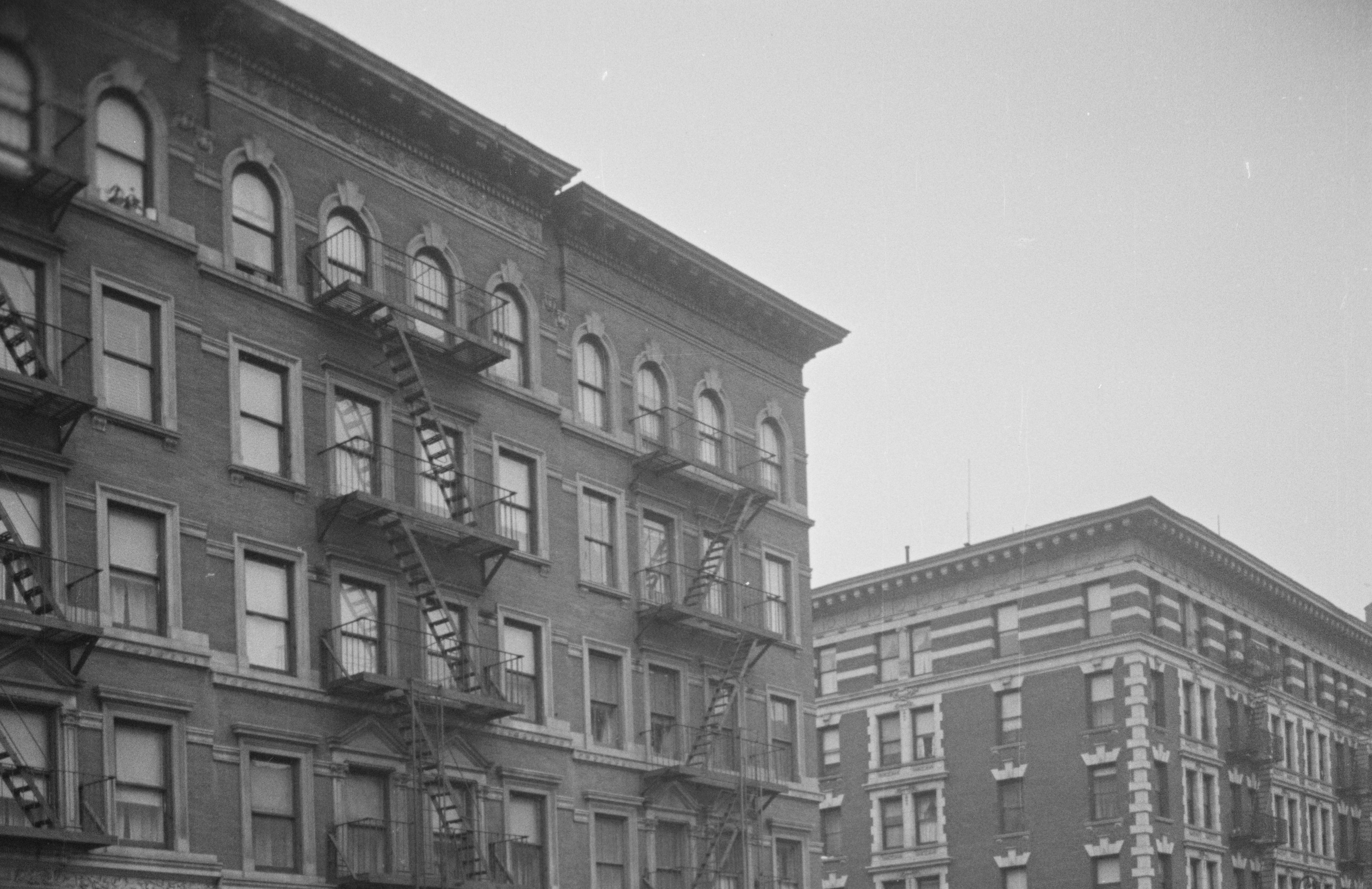
20-22 Manhattan Avenue
by Tom Miller
In 1896, partners Conrad R. Gross and George Herbener hired the architectural firm of Neville & Bagge to design four five-story “brick flats” on the northeast corner of Manhattan Avenue and West 101st Street. Each four-bays wide on the avenue, they were clad in red brick above limestone-faced bases. Their Renaissance Revival design included elaborate foliate carvings and classical pediments. The openings of the first and fifth floors were fully arched, while those of the second through third sat within squared, architrave stone frames. Each building wore prominent cornices on scrolled brackets. While the corner building took the address of 20 Manhattan Avenue, its entrance was around the corner at 21 West 101st Street. The apartments were leased to upper-middle-class tenants.
Albert Sutton lived at 22 Manhattan Avenue at the turn of the century. A clerk, he developed what The Morning Telegraph described as “a nervous disorder” early in 1901. He was admitted to the Presbyterian Hospital for treatment. Early on the morning of February 8, “while the change was being made from the night to the day shifts of nurses,” according to the article, he slipped away from his room unnoticed. The newspaper said, “he managed to get into the operating room unobserved and hang himself by a rope attached to some lifting tackle.”
About a block away, at Columbus Avenue and 103rd Street, was the St. Brenan Hotel. In the summer of 1912, the hotel was investigated as a disorderly house—a polite term for a brothel. At least two residents of 20 Manhattan Avenue were subpoenaed to testify in June. Dr. Elmer Russell and Samuel G. Raymond, a contractor, swore that they had taken their wives there many times for dinner—Raymond saying “generally twice a week”—and had never seen anyone whose character could be questioned. The prosecutor hammered both men regarding “the reputation of the women who frequent this hotel,” but neither relented.
At least two residents of 20 Manhattan Avenue were subpoenaed to testify in June.
When America entered World War I, at least two residents, Charles N. Shaffer, who lived in No. 20, and David Bray, who lived in No. 22, entered the military. In 1918, Shaffer had achieved the rank of ensign in the U.S. Navy, while Bray was a private in the U.S. Army.
Living next door that year was Marie Mahoney, who worked as a waitress in a restaurant on Sixth Avenue. During her dinner break on the night of March 29, she sat down to eat at a table with another waitress, Katherine Bishop, and the counterman, William Dierks. The 33-year-old Dierks, who was described as “a quiet man,” by The Sun, had left Germany around the time that the war began.
At the time, newspapers were filled with reports of the German Army’s relentless drive on the western front in Europe. The Sun reported, “He turned suddenly to the two young women and made an insulting remark about Americans and said that ‘they would now get what was coming to them.’” One of the women called a policeman and Dierks was arrested. At the stationhouse, Katherine Bishop and her co-worker were asked why he “hadn’t been forcibly decorated with a bowl of soup.” They answered, “The soup was too good to spoil on him.” Dierks was charged with “insulting the American Government and the American flag.”
Later that year, residents of 22 Manhattan Avenue were informed that David Bray was killed in action on September 5.
Julia Martinitz, a former Spanish dancer, lived at 20 Manhattan Avenue in 1936 with her five children, including 15-year-old daughter, Jane. Julia was separated from her husband, John, and on September 21 that year, she took him to court for non-support. (John was living under a crippling court order. The milk deliverer made $48 per week and was ordered to pay Julia $30 each week.) In the courtroom, Martinitz tried to change the focus from support to morality. Jane was dancing as a chorus girl at the Paradise Club. John pleaded, “that his wife was impairing the morals of their daughter.”
Julia turned the issue back to non-support. “Lack of money was the reason Jane went to the Paradise to work,” she told the court. The judge reminded the parties of the issue at hand and that a hearing on the dancing was scheduled for a later date. Julia spit angrily, “After she’s sixteen there’s nothing the courts can do.”
Beleaguered today, 20 and 22 Manhattan Avenue are the sole survivors of the 1896 row.
At least two more residents left Manhattan Avenue to fight for their country at the outbreak of World War II. Thomas P. Rigney shared an apartment with his brother, Bernard M., in No. 20; and Michael Pappas lived with his sister and family, Katherine Reilly, at 22 Manhattan Avenue. Thomas Rigney became a gunnery sergeant with the U.S. Marine Corps, and Pappas was a private in the U.S. Army. Rigney was killed in battle and Pappas was wounded.
In the second half of the 20th century, 20 and 22 Manhattan Avenue were internally combined. Their impressive entrances were closed off and the entrance moved to below grade on 101st Street. The cornices and decorative friezes were likely removed during this renovation. Beleaguered today, 20 and 22 Manhattan Avenue are the sole survivors of the 1896 row.
Tom Miller is a social historian and blogger at daytoninmanhattan.blogspot.com


